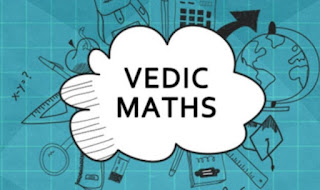VEDIC MATHS-45
VEDIC MATHS
By OMKAR TENDOLKAR
This is post number 45 from the series of "Vedic maths" blogs. Here in this blog we will learn about "Base Method of Division part-2"
The base method of division is having large contribution in Vedic Mathematics. The name Base method is given by Vedic Mathematics in western countries.
The study of division is divided in two parts. In this post we will study the Base Method and in the next blogs we will study the Paravartya Method of division.
We have seen the applications of the Base Method in multiplication and squaring of numbers in previous blogs. In this method we use power of ten as a base and then calculate the difference between the base and the given number. The same concept will be used for division.
Examples:
1.Divide 502 by 99
100
2. Divide 617 by 95
100
Answer:
10
- The base 10 has one zero and therefore we split the dividend in such a way that the RHS has one digit.
- Now we are left with two digits on the LHS.
- We bring down the first digit 1 as it is.
- We multiply the 1 with the difference 1 and put the answer below the second digit of the dividend.
- The second digit of the dividend is 2 and we add 1 to it. The total is 3.
10
- We now multiply the total 3 with the difference 1 and write the product, viz. 3 below the third digit of the dividend.
- The total is 6.
100
- We bring down 1 and multiply it with 02. The product 02 is written down from the second digit of the dividend.
- We now add 2 plus 0 downwards and get the second digit of the quotient. The answer is 2.
- We multiply 2 with 02 and the final answer 04 is written down from the third digit of the dividend.
- We add up the numbers on the RHS from the extreme right column. The total of 4 + 4 is 8. We come to the column on the left and add 3 + 2 + 0 = 5.
- Hence, the product is 12 and the remainder is 58.
- 2122 / 97, then quotient is 21 and remainder is 85.
- 10113 / 998, then quotient is 10 and remainder is 133.
- 1005 / 99, then quotient is 10 and remainder is 15.
1. 465 / 98
2. 3887 / 98
3. 4007 / 997
You may answer this in comment box. You may ask your any query or doubt in comment box. I will try to resolve as early as possible.
In next blog we will discuss about "Example of Base Method of Division part-3".
We will meet very soon through our next blog. Till that stay connected, stay healthy and stay safe.
Thanks
for giving your valuable time.
Good day😊.


Comments
Post a Comment